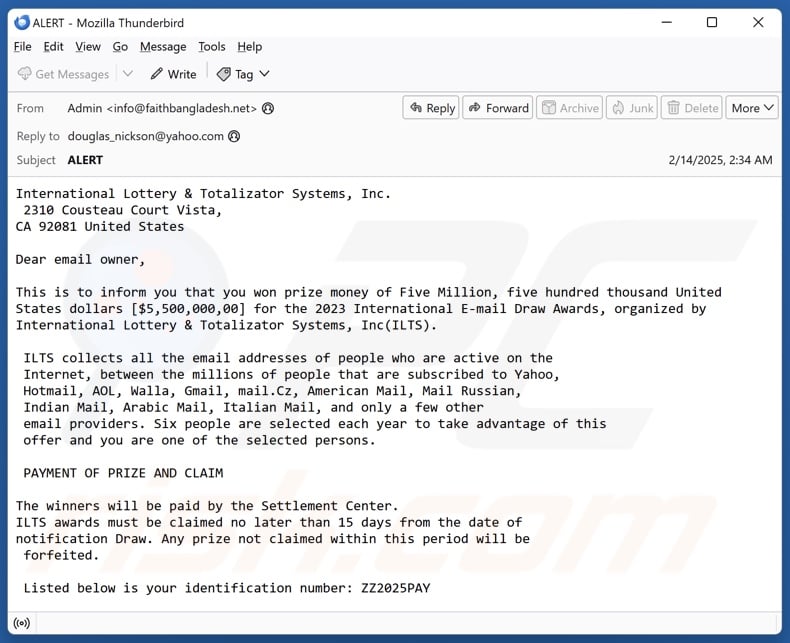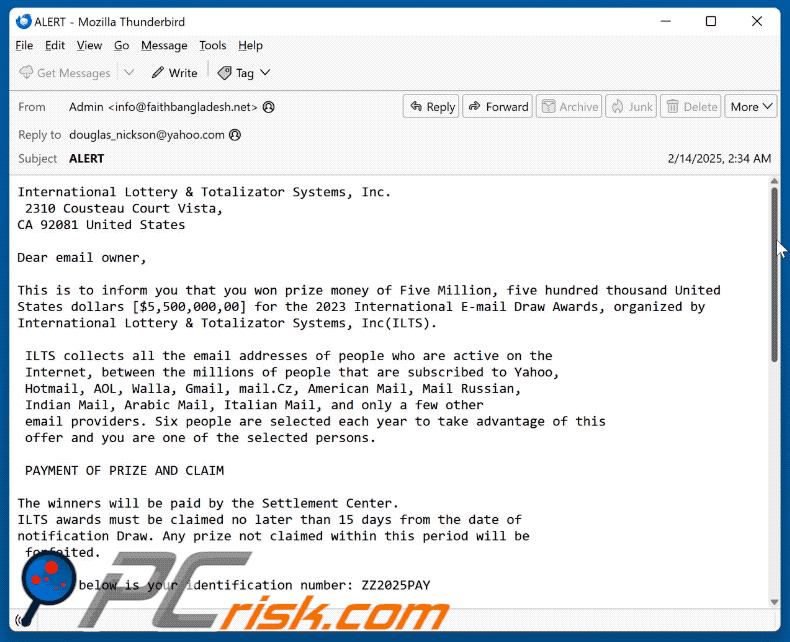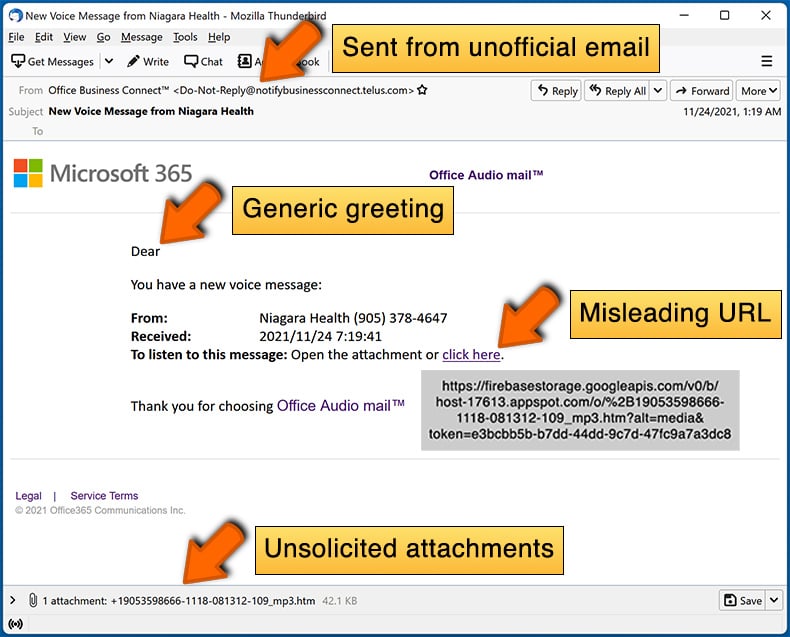How to identify fake emails like "International Lottery & Totalizator Systems"
Phishing/ScamAlso Known As: "International Lottery & Totalizator Systems" phishing email
Get free scan and check if your device is infected.
Remove it nowTo use full-featured product, you have to purchase a license for Combo Cleaner. Seven days free trial available. Combo Cleaner is owned and operated by RCS LT, the parent company of PCRisk.com.
What kind of email is "International Lottery & Totalizator Systems"?
Our inspection of the "International Lottery & Totalizator Systems" email revealed that it is spam. This message claims that the recipient has won 5.5 million USD.
The purpose is to deceive them into disclosing personal information and possibly luring victims into transferring funds to scammers. It must be emphasized that this phishing email is not associated with any legitimate entities.

"International Lottery & Totalizator Systems" email scam overview
The spam email with the subject "ALERT" (may vary) informs the recipient that they have won $5,500,000. The modus operandi of this lottery is collecting email addresses associated with various mail service providers and choosing six winners. The winner must claim their award within 15 days, else the prize will be forfeited.
It must be reiterated that the information in this email is false, and this mail is in no way associated with any genuine entities.
The message requests the recipient to provide their following information: full name, birthdate, age, sex, occupation, state (country/region), address, telephone number, and email address. This personally identifiable data can be used for a variety of nefarious purposes, including to steal victims' identities.
Scammers may also ask victims to send them money for legitimate-sounding reasons (e.g., paying taxes, transaction fees, etc.).
To summarize, by trusting an email like "International Lottery & Totalizator Systems" – users can experience severe privacy issues, financial losses, and identity theft.
If you have already provided your personally identifiable or financial information (e.g., ID card details, passport photos/scans, credit/debit card numbers, etc.) to scammers – immediately contact the appropriate authorities.
| Name | "International Lottery & Totalizator Systems" phishing email |
| Threat Type | Phishing, Scam, Social Engineering, Fraud |
| Fake Claim | Recipient has won 5.5 million USD in a lottery. |
| Symptoms | Unauthorized online purchases, changed online account passwords, identity theft, illegal access of the computer. |
| Distribution methods | Deceptive emails, rogue online pop-up ads, search engine poisoning techniques, misspelled domains. |
| Damage | Loss of sensitive private information, monetary loss, identity theft. |
| Malware Removal (Windows) |
To eliminate possible malware infections, scan your computer with legitimate antivirus software. Our security researchers recommend using Combo Cleaner. Download Combo CleanerTo use full-featured product, you have to purchase a license for Combo Cleaner. 7 days free trial available. Combo Cleaner is owned and operated by RCS LT, the parent company of PCRisk.com. |
Phishing spam campaign examples
We have investigated countless spam campaigns; "Login From A New Device", "OneDrive - Encrypted EFT Document", "One Time Verification", "Netflix Account Suspended", and "Overdue Contract Funds" are just some of our latest articles on phishing emails.
In addition to personally identifiable information, these messages commonly target log-in credentials of various accounts and finance-related data. However, other types of scams are also promoted through spam mail. It is utilized in malware distribution as well.
Due to how prevalent this mail is and how well-made it can be – we strongly advise exercising caution with incoming emails, PMs/DMs, SMSes, and other messages.
How do spam campaigns infect computers?
Spam campaigns proliferate malware through virulent files that can be attached to or linked inside the emails/messages. These files come in various formats, e.g., documents (PDF, Microsoft Office, Microsoft OneNote, etc.), archives (ZIP, RAR, etc.), executables (.exe, .run, etc.), JavaScript, and so on.
Malware download/installation is triggered once such a file is opened. However, some formats require additional user interaction to initiate infection processes. For example, Microsoft Office files need users to enable macro commands (i.e., editing/content), while OneNote documents require them to click on embedded links or files.
How to avoid installation of malware?
Caution is essential to device and user safety. Therefore, approach incoming emails and other messages with care. Do not open attachments or links found in dubious/irrelevant mail since they can be harmful or infectious.
It must be mentioned that malware is spread using various methods. Hence, be vigilant while browsing since the Internet is full of deceptive and dangerous content.
Additionally, download only from official and trustworthy channels. Activate and update software using functions/tools provided by legitimate developers, as illegal product activation tools ("cracks") and third-party updates can contain malware.
It is paramount to have a reputable anti-virus installed and kept updated. Security programs must be used to perform regular system scans and to remove detected threats. If you've already opened malicious attachments, we recommend running a scan with Combo Cleaner Antivirus for Windows to automatically eliminate infiltrated malware.
Text presented in the "International Lottery & Totalizator Systems" spam email letter:
Subject: ALERT
International Lottery & Totalizator Systems, Inc.
2310 Cousteau Court Vista,
CA 92081 United States
Dear email owner,
This is to inform you that you won prize money of Five Million, five hundred thousand United States dollars [$5,500,000,00] for the 2023 International E-mail Draw Awards, organized by International Lottery & Totalizator Systems, Inc(ILTS).
ILTS collects all the email addresses of people who are active on the
Internet, between the millions of people that are subscribed to Yahoo,
Hotmail, AOL, Walla, Gmail, mail.Cz, American Mail, Mail Russian,
Indian Mail, Arabic Mail, Italian Mail, and only a few other
email providers. Six people are selected each year to take advantage of this
offer and you are one of the selected persons.
PAYMENT OF PRIZE AND CLAIM
The winners will be paid by the Settlement Center.
ILTS awards must be claimed no later than 15 days from the date of
notification Draw. Any prize not claimed within this period will be
forfeited.
Listed below is your identification number: ZZ2025PAY
These figures, which fall within the America Location file [ALF], you
are asked to contact our fiduciary agent in the United States[Mr. Andreaw]
Agent Name: Mr Andreaw
E-Mail: Andreawtason@gmail.com
Lottery winner's form of payment requests.
FullName :
Date of Birth :
ADDRESS :
SEX :
AGE :
State :
Occupation :
TELEPHONE :
EMAIL :
The winner's reference/batch No : WIN025WIN(for Approval).
This would begin the process that will permit the release of your prize money. Please note that you are obligated to remit the service charge to aid the successful disbursement of your prize.
Congratulations!!!
Kind Regards,
Andreaw Tason
(International Lottery & Totalizator Systems, Inc 2025)
Appearance of the "International Lottery & Totalizator Systems" spam email (GIF):

Instant automatic malware removal:
Manual threat removal might be a lengthy and complicated process that requires advanced IT skills. Combo Cleaner is a professional automatic malware removal tool that is recommended to get rid of malware. Download it by clicking the button below:
DOWNLOAD Combo CleanerBy downloading any software listed on this website you agree to our Privacy Policy and Terms of Use. To use full-featured product, you have to purchase a license for Combo Cleaner. 7 days free trial available. Combo Cleaner is owned and operated by RCS LT, the parent company of PCRisk.com.
Quick menu:
- What is "International Lottery & Totalizator Systems" phishing email?
- Types of malicious emails.
- How to spot a malicious email?
- What to do if you fell for an email scam?
Types of malicious emails:
![]() Phishing Emails
Phishing Emails
Most commonly, cybercriminals use deceptive emails to trick Internet users into giving away their sensitive private information, for example, login information for various online services, email accounts, or online banking information.
Such attacks are called phishing. In a phishing attack, cybercriminals usually send an email message with some popular service logo (for example, Microsoft, DHL, Amazon, Netflix), create urgency (wrong shipping address, expired password, etc.), and place a link which they hope their potential victims will click on.
After clicking the link presented in such email message, victims are redirected to a fake website that looks identical or extremely similar to the original one. Victims are then asked to enter their password, credit card details, or some other information that gets stolen by cybercriminals.
![]() Emails with Malicious Attachments
Emails with Malicious Attachments
Another popular attack vector is email spam with malicious attachments that infect users' computers with malware. Malicious attachments usually carry trojans that are capable of stealing passwords, banking information, and other sensitive information.
In such attacks, cybercriminals' main goal is to trick their potential victims into opening an infected email attachment. To achieve this goal, email messages usually talk about recently received invoices, faxes, or voice messages.
If a potential victim falls for the lure and opens the attachment, their computers get infected, and cybercriminals can collect a lot of sensitive information.
While it's a more complicated method to steal personal information (spam filters and antivirus programs usually detect such attempts), if successful, cybercriminals can get a much wider array of data and can collect information for a long period of time.
![]() Sextortion Emails
Sextortion Emails
This is a type of phishing. In this case, users receive an email claiming that a cybercriminal could access the webcam of the potential victim and has a video recording of one's masturbation.
To get rid of the video, victims are asked to pay a ransom (usually using Bitcoin or another cryptocurrency). Nevertheless, all of these claims are false - users who receive such emails should ignore and delete them.
How to spot a malicious email?
While cyber criminals try to make their lure emails look trustworthy, here are some things that you should look for when trying to spot a phishing email:
- Check the sender's ("from") email address: Hover your mouse over the "from" address and check if it's legitimate. For example, if you received an email from Microsoft, be sure to check if the email address is @microsoft.com and not something suspicious like @m1crosoft.com, @microsfot.com, @account-security-noreply.com, etc.
- Check for generic greetings: If the greeting in the email is "Dear user", "Dear @youremail.com", "Dear valued customer", this should raise suspiciousness. Most commonly, companies call you by your name. Lack of this information could signal a phishing attempt.
- Check the links in the email: Hover your mouse over the link presented in the email, if the link that appears seems suspicious, don't click it. For example, if you received an email from Microsoft and the link in the email shows that it will go to firebasestorage.googleapis.com/v0... you shouldn't trust it. It's best not to click any links in the emails but to visit the company website that sent you the email in the first place.
- Don't blindly trust email attachments: Most commonly, legitimate companies will ask you to log in to their website and to view any documents there; if you received an email with an attachment, it's a good idea to scan it with an antivirus application. Infected email attachments are a common attack vector used by cybercriminals.
To minimise the risk of opening phishing and malicious emails we recommend using Combo Cleaner Antivirus for Windows.
Example of a spam email:

What to do if you fell for an email scam?
- If you clicked on a link in a phishing email and entered your password - be sure to change your password as soon as possible. Usually, cybercriminals collect stolen credentials and then sell them to other groups that use them for malicious purposes. If you change your password in a timely manner, there's a chance that criminals won't have enough time to do any damage.
- If you entered your credit card information - contact your bank as soon as possible and explain the situation. There's a good chance that you will need to cancel your compromised credit card and get a new one.
- If you see any signs of identity theft - you should immediately contact the Federal Trade Commission. This institution will collect information about your situation and create a personal recovery plan.
- If you opened a malicious attachment - your computer is probably infected, you should scan it with a reputable antivirus application. For this purpose, we recommend using Combo Cleaner Antivirus for Windows.
- Help other Internet users - report phishing emails to Anti-Phishing Working Group, FBI’s Internet Crime Complaint Center, National Fraud Information Center and U.S. Department of Justice.
Frequently Asked Questions (FAQ)
Why did I receive this email?
Regardless of any relevant information that spam emails may include – they are not personal. These messages are distributed in large-scale campaigns, so thousands of users receive identical (or incredibly similar) emails.
I have provided my personal information when tricked by this spam email, what should I do?
If you have disclosed your log-in credentials – change the passwords of all possibly exposed accounts and inform their official support without delay. And if you have provided other private data (e.g., ID card details, credit card numbers, etc.) – immediately contact the corresponding authorities.
I have read a spam email but didn't open the attachment, is my computer infected?
Merely reading an email does not pose an infection threat. Systems are infected when malicious attachments or links are opened/clicked.
I have downloaded and opened a file attached to a spam email, is my computer infected?
File formats can influence infection success rates. Once opened, executables (.exe, .run, etc.) cause infections almost without fail. However, some formats – like documents (.doc, .xls, .pdf, etc.) – need additional user interaction. Hence, malware download/installation is triggered after macro commands are enabled, embedded files/links are clicked, or other actions are performed.
Will Combo Cleaner remove malware infections present in email attachments?
Combo Cleaner can scan computers and eliminate all kinds of threats. It is capable of detecting and removing most of the known malware infections. Remember that high-end malicious software tends to hide deep within systems – therefore, performing a complete system scan is crucial.
Share:

Tomas Meskauskas
Expert security researcher, professional malware analyst
I am passionate about computer security and technology. I have an experience of over 10 years working in various companies related to computer technical issue solving and Internet security. I have been working as an author and editor for pcrisk.com since 2010. Follow me on Twitter and LinkedIn to stay informed about the latest online security threats.
PCrisk security portal is brought by a company RCS LT.
Joined forces of security researchers help educate computer users about the latest online security threats. More information about the company RCS LT.
Our malware removal guides are free. However, if you want to support us you can send us a donation.
DonatePCrisk security portal is brought by a company RCS LT.
Joined forces of security researchers help educate computer users about the latest online security threats. More information about the company RCS LT.
Our malware removal guides are free. However, if you want to support us you can send us a donation.
Donate
▼ Show Discussion